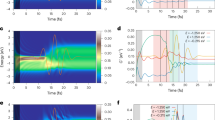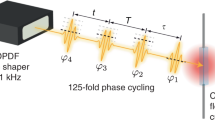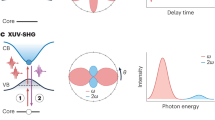Abstract
Quantum states depend on the coordinates of all their constituent particles, with essential multi-particle correlations. Time-resolved laser spectroscopy1 is widely used to probe the energies and dynamics of excited particles and quasiparticles such as electrons and holes2,3, excitons4,5,6, plasmons7, polaritons8 or phonons9. However, nonlinear signals from single- and multiple-particle excitations are all present simultaneously and cannot be disentangled without a priori knowledge of the system4,10. Here, we show that transient absorption—the most commonly used nonlinear spectroscopy—with N prescribed excitation intensities allows separation of the dynamics into N increasingly nonlinear contributions; in systems well-described by discrete excitations, these N contributions systematically report on zero to N excitations. We obtain clean single-particle dynamics even at high excitation intensities and can systematically increase the number of interacting particles, infer their interaction energies and reconstruct their dynamics, which are not measurable via conventional means. We extract single- and multiple-exciton dynamics in squaraine polymers11,12 and, contrary to common assumption6,13, we find that the excitons, on average, meet several times before annihilating. This surprising ability of excitons to survive encounters is important for efficient organic photovoltaics14,15. As we demonstrate on five diverse systems, our procedure is general, independent of the measured system or type of observed (quasi)particle and straightforward to implement. We envision future applicability in the probing of (quasi)particle interactions in such diverse areas as plasmonics7, Auger recombination2 and exciton correlations in quantum dots5,16,17, singlet fission18, exciton interactions in two-dimensional materials19 and in molecules20,21, carrier multiplication22, multiphonon scattering9 or polariton–polariton interaction8.
This is a preview of subscription content, access via your institution
Access options
Access Nature and 54 other Nature Portfolio journals
Get Nature+, our best-value online-access subscription
$29.99 / 30 days
cancel any time
Subscribe to this journal
Receive 51 print issues and online access
$199.00 per year
only $3.90 per issue
Buy this article
- Purchase on Springer Link
- Instant access to full article PDF
Prices may be subject to local taxes which are calculated during checkout




Similar content being viewed by others
Data availability
The data supporting the findings of this study are given in graphic form in the paper (including the Supplementary Information). Source data are provided with this paper. Additional raw data are available from the corresponding authors on reasonable request.
Code availability
All codes needed to evaluate the conclusions in the paper are described in the paper and the source code for the numerical calculations is available openly online55.
Change history
01 August 2023
A Correction to this paper has been published: https://doi.org/10.1038/s41586-023-06476-9
References
Mukamel, S. Principles of Nonlinear Optical Spectroscopy (Oxford Univ. Press, 1995).
Klimov, V. I., Mikhailovsky, A. A., McBranch, D. W., Leatherdale, C. A. & Bawendi, M. G. Quantization of multiparticle Auger rates in semiconductor quantum dots. Science 287, 1011–1013 (2000).
Almand-Hunter, A. E. et al. Quantum droplets of electrons and holes. Nature 506, 471–475 (2014).
Valkunas, L., Trinkunas, G., Liuolia, V. & van Grondelle, R. Nonlinear annihilation of excitations in photosynthetic systems. Biophys. J. 69, 1117–1129 (1995).
Stone, K. W. et al. Two-quantum 2D FT electronic spectroscopy of biexcitons in GaAs quantum wells. Science 324, 1169–1173 (2009).
Kriete, B. et al. Interplay between structural hierarchy and exciton diffusion in artificial light harvesting. Nat. Commun. 10, 4615 (2019).
You, C., Nellikka, A. C., De Leon, I. & Magaña-Loaiza, O. S. Multiparticle quantum plasmonics. Nanophotonics 9, 1243–1269 (2020).
Sun, Y. et al. Direct measurement of polariton–polariton interaction strength. Nat. Phys. 13, 870–875 (2017).
Giura, P. et al. Multiphonon anharmonicity of MgO. Phys. Rev. B 99, 220304 (2019).
Joo, T., Jia, Y., Yu, J., Lang, M. J. & Fleming, G. R. Third‐order nonlinear time domain probes of solvation dynamics. J. Chem. Phys. 104, 6089–6108 (1996).
Malý, P. et al. From wavelike to sub-diffusive motion: exciton dynamics and interaction in squaraine copolymers of varying length. Chem. Sci. 11, 456–466 (2020).
Völker, S. F. et al. Singlet–singlet exciton annihilation in an exciton-coupled squaraine-squaraine copolymer: a model toward hetero-J-aggregates. J. Phys. Chem. C 118, 17467–17482 (2014).
Rehhagen, C. et al. Exciton migration in multistranded perylene bisimide J-aggregates. J. Phys. Chem. Lett. 11, 6612–6617 (2020).
Tzabari, L., Zayats, V. & Tessler, N. Exciton annihilation as bimolecular loss in organic solar cells. J. Appl. Phys. 114, 154514 (2013).
Steiner, F., Vogelsang, J. & Lupton, J. M. Singlet-triplet annihilation limits exciton yield in poly(3-hexylthiophene). Phys. Rev. Lett. 112, 137402 (2014).
Zhu, H., Yang, Y. & Lian, T. Multiexciton annihilation and dissociation in quantum confined semiconductor nanocrystals. Acc. Chem. Res. 46, 1270–1279 (2013).
Palato, S. et al. Investigating the electronic structure of confined multiexcitons with nonlinear spectroscopies. J. Chem. Phys. 152, 104710 (2020).
Smith, M. B. & Michl, J. Singlet fission. Chem. Rev. 110, 6891–6936 (2010).
Purz, T. L. et al. Coherent exciton–exciton interactions and exciton dynamics in a MoSe 2/WSe 2 heterostructure. Phys. Rev. B 104, L241302 (2021).
Dostál, J. et al. Direct observation of exciton–exciton interactions. Nat. Commun. 9, 2466 (2018).
Heshmatpour, C. et al. Annihilation dynamics of molecular excitons measured at a single perturbative excitation energy. J. Phys. Chem. Lett. 11, 7776–7781 (2020).
Ueda, A., Matsuda, K., Tayagaki, T. & Kanemitsu, Y. Carrier multiplication in carbon nanotubes studied by femtosecond pump-probe spectroscopy. Appl. Phys. Lett. 92, 233105 (2008).
Bennett, D. I. G., Fleming, G. R. & Amarnath, K. Energy-dependent quenching adjusts the excitation diffusion length to regulate photosynthetic light harvesting. Proc. Natl Acad. Sci. USA 115, E9523–E9531 (2018).
Polman, A., Knight, M., Garnett, E. C., Ehrler, B. & Sinke, W. C. Photovoltaic materials: present efficiencies and future challenges. Science 352, aad4424 (2016).
Müller, M. G. et al. Singlet energy dissipation in the photosystem II light-harvesting complex does not involve energy transfer to carotenoids. ChemPhysChem 11, 1289–1296 (2010).
Auston, D. H., Shank, C. V. & LeFur, P. Picosecond optical measurements of band-to-band Auger recombination of high-density plasmas in germanium. Phys. Rev. Lett. 35, 1022–1025 (1975).
Smith, G. O., Mayer, E. J., Kuhl, J. & Ploog, K. Pump-probe investigations of biexcitons in GaAs quantum wells. Solid State Commun. 92, 325–329 (1994).
Smith, R. P. et al. Extraction of many-body configurations from nonlinear absorption in semiconductor quantum wells. Phys. Rev. Lett. 104, 247401 (2010).
Sun, D. et al. Observation of rapid exciton–exciton annihilation in monolayer molybdenum disulfide. Nano Lett. 14, 5625–5629 (2014).
Taguchi, S., Saruyama, M., Teranishi, T. & Kanemitsu, Y. Quantized Auger recombination of biexcitons in CdSe nanorods studied by time-resolved photoluminescence and transient-absorption spectroscopy. Phys. Rev. B 83, 155324 (2011).
Chlouba, T. et al. Pathways of carrier recombination in Si/SiO2 nanocrystal superlattices. J. Appl. Phys. 126, 163101 (2019).
Pedersen, S., Baumert, T. & Zewail, A. H. Femtosecond real-time probing of reactions. 13. Multiphoton dynamics of mercury iodide (IHgI). J. Phys. Chem. 97, 12460–12465 (1993).
Yokoyama, K., Silva, C., Son, D. H., Walhout, P. K. & Barbara, P. F. Detailed investigation of the femtosecond pump–probe spectroscopy of the hydrated electron. J. Phys. Chem. A 102, 6957–6966 (1998).
Bittner, T., Irrgang, K.-D., Renger, G. & Wasielewski, M. R. Ultrafast excitation energy transfer and exciton–exciton annihilation processes in isolated light harvesting complexes of photosystem II (LHC II) from spinach. J. Phys. Chem. 98, 11821–11826 (1994).
Brüggemann, B. & May, V. Exciton exciton annihilation dynamics in chromophore complexes. II. Intensity dependent transient absorption of the LH2 antenna system. J. Chem. Phys. 120, 2325–2336 (2004).
Birkmeier, K., Hertel, T. & Hartschuh, A. Probing the ultrafast dynamics of excitons in single semiconducting carbon nanotubes. Nat. Commun. 13, 6290 (2022).
Kira, M., Koch, S. W., Smith, R. P., Hunter, A. E. & Cundiff, S. T. Quantum spectroscopy with Schrödinger-cat states. Nat. Phys. 7, 799–804 (2011).
Leo, K. et al. Effects of coherent polarization interactions on time-resolved degenerate four-wave mixing. Phys. Rev. Lett. 65, 1340–1343 (1990).
Tan, H.-S. Theory and phase-cycling scheme selection principles of collinear phase coherent multi-dimensional optical spectroscopy. J. Chem. Phys. 129, 124501 (2008).
Brüggemann, B. & Pullerits, T. Nonperturbative modeling of fifth-order coherent multidimensional spectroscopy in light harvesting antennas. New J. Phys. 13, 025024 (2011).
van Amerongen, H. & van Grondelle, R. Understanding the energy transfer function of LHCII, the major light-harvesting complex of green plants. J. Phys. Chem. B 105, 604–617 (2001).
Barzda, V. et al. Singlet–singlet annihilation kinetics in aggregates and trimers of LHCII. Biophys. J. 80, 2409–2421 (2001).
Kostjukov, V. V. Photoexcitation of cresyl violet dye in aqueous solution: TD-DFT study. Theor. Chem. Acc. 140, 155 (2021).
Diels, J.-C. & Rudolph, W. Ultrashort Laser Pulse Phenomena: Fundamentals, Techniques, and Applications on a Femtosecond Time Scale (Academic Press, 1996).
Yu, S., Titze, M., Zhu, Y., Liu, X. & Li, H. Observation of scalable and deterministic multi-atom Dicke states in an atomic vapor. Opt. Lett. 44, 2795–2798 (2019).
Bangert, U., Bruder, L. & Stienkemeier, F. Pulse overlap ambiguities in multiple quantum coherence spectroscopy. Opt. Lett. 48, 538–541 (2023).
Seiler, H., Palato, S. & Kambhampati, P. Investigating exciton structure and dynamics in colloidal CdSe quantum dots with two-dimensional electronic spectroscopy. J. Chem. Phys. 149, 074702 (2018).
Sewall, S. L., Cooney, R. R., Anderson, K. E. H., Dias, E. A. & Kambhampati, P. State-to-state exciton dynamics in semiconductor quantum dots. Phys. Rev. B 74, 235328 (2006).
Chlouba, T. et al. Interplay of bimolecular and Auger recombination in photoexcited carrier dynamics in silicon nanocrystal/silicon dioxide superlattices. Sci. Rep. 8, 1703 (2018).
Biggs, J. D., Voll, J. A. & Mukamel, S. Coherent nonlinear optical studies of elementary processes in biological complexes: diagrammatic techniques based on the wave function versus the density matrix. Philos. Trans. R. Soc. A 370, 3709 (2012).
Abramavičius, D. Revealing a full quantum ladder by nonlinear spectroscopy. Lith. J. Phys. 60, 154–166 (2020).
Liu, Z. et al. Crystal structure of spinach major light-harvesting complex at 2.72 Å resolution. Nature 428, 287–292 (2004).
van Grondelle, R. & Novoderezhkin, V. I. Energy transfer in photosynthesis: experimental insights and quantitative models. Phys. Chem. Chem. Phys. 8, 793–807 (2006).
Trebino, R. Frequency-Resolved Optical Gating: The Measurement of Ultrashort Laser Pulses (Springer, 2002).
Krich, J. J., Rose, P. A. & Malý, P. Software for “Separating single- from multi-particle dynamics in nonlinear spectroscopy”. Zenodo https://doi.org/10.5281/zenodo.7675564 (2023).
Acknowledgements
We are indebted to H. Lokstein for providing the LHCII sample and to D. Hiller and F. Trojánek for letting us measure the silicon nanocrystal sample. We thank S. Büttner who measured cresyl violet on the new 100 kHz setup. We thank G. R. Fleming for reading the manuscript and useful suggestions. The work was supported by the Deutsche Forschungsgemeinschaft (DFG, German Research Foundation) grant no. 423942615 to T.B. and by the SolTech Initiative of the Bavarian State Ministry of Education, Culture, Science and the Arts (C.L. and T.B.). J.K. and P.R. were supported by the Natural Science and Engineering Research Council of Canada (NSERC). J.L. acknowledges support by the Cusanuswerk and P.M. was supported by the Alexander von Humboldt Foundation.
Author information
Authors and Affiliations
Contributions
T.B., P.M., J.L., P.A.R. and J.J.K. conceived the project. A.T. and C.L. synthesized the squaraine polymers used for measurement. P.M. and J.L. designed the experiments and together with P.A.R. analysed the results. P.M., P.A.R. and J.J.K. formulated the theoretical description of the data. All authors discussed the results. T.B. and J.J.K. supervised the project. P.M. and T.B. wrote the manuscript with input from all co-authors.
Corresponding authors
Ethics declarations
Competing interests
The authors declare no competing interests.
Peer review
Peer review information
Nature thanks the anonymous reviewers for their contribution to the peer review of this work. Peer reviewer reports are available.
Additional information
Publisher’s note Springer Nature remains neutral with regard to jurisdictional claims in published maps and institutional affiliations.
Extended data figures and tables
Extended Data Fig. 1 Third-order signals of diverse samples.
a, Light-harvesting complex II. b, Cresyl violet dye. c, CdSe/Zns core-shell quantum dots and d, silicon nanocrystals. For all samples their structure is shown at the top part of the panels. At the bottom part the transient signal maps are shown. The transient maps contain regions indicated with solid, dashed, and dotted borders whose spectrally integrated signals are shown as solid, dashed, and dotted curves on top. Blue: PP(3) signals, black: low-power reference measurement.
Extended Data Fig. 2 Scheme of the experimental setup used for the squaraine polymer measurement.
The probe beam was attenuated by a filter wheel; the intensity of the pump beam was adjusted using the Dazzler pulse shaper. The half-wave plate \(\frac{\lambda }{2}\) was used to rotate the pump polarization to magic angle between the pump and probe polarization to measure the isotropic signal.
Supplementary information
Supplementary Information
Supplementary Sections 1–8, including Figs. 1–23 and Tables 1–5.
Rights and permissions
Springer Nature or its licensor (e.g. a society or other partner) holds exclusive rights to this article under a publishing agreement with the author(s) or other rightsholder(s); author self-archiving of the accepted manuscript version of this article is solely governed by the terms of such publishing agreement and applicable law.
About this article
Cite this article
Malý, P., Lüttig, J., Rose, P.A. et al. Separating single- from multi-particle dynamics in nonlinear spectroscopy. Nature 616, 280–287 (2023). https://doi.org/10.1038/s41586-023-05846-7
Received:
Accepted:
Published:
Issue Date:
DOI: https://doi.org/10.1038/s41586-023-05846-7
This article is cited by
-
Nonclassical near-field dynamics of surface plasmons
Nature Physics (2024)
-
Exciton annihilation in molecular aggregates suppressed through quantum interference
Nature Chemistry (2023)
-
Plasmon mediated coherent population oscillations in molecular aggregates
Nature Communications (2023)
-
Two-dimensional electronic spectroscopy
Nature Reviews Methods Primers (2023)
Comments
By submitting a comment you agree to abide by our Terms and Community Guidelines. If you find something abusive or that does not comply with our terms or guidelines please flag it as inappropriate.



